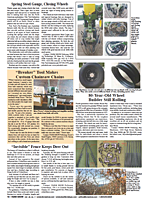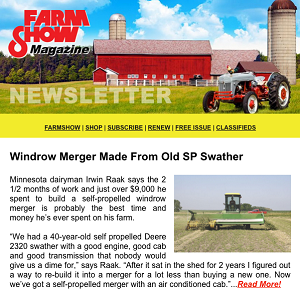Collection Helps Him Teach The History Of Toast
There’s really no good explanation why Wayne Konkel started collecting toasters about 35 years ago. He just sort of fell into it when he found a couple of old toasters in the basement that his mother had saved. Being from a frugal Kansas farm family, Konkel decided to see if they worked. He tore them apart, repaired a few wires, brushed off the rust, polished them up, plugged them in, and celebrated by making toast.
After that he started noticing toasters at flea markets and antique shops. When a dealer mentioned that irons and waffle irons sort of fit with toaster collecting, he added those, too.
Konkel estimates he has about 200 toasters, 120 irons and 95 waffle irons. Most of them are displayed at the Pratt County Historical Museum on 6 shelves that wrap around the walls of one of the museum’s rooms (www.prattcountymuseum.org).
“What surprises me is that about 90 percent of them worked when I got them,” Konkel says. Most of his repairs are on the cord or plug-in, and he switches out the heating elements on some toasters from a stock of toasters he keeps for parts. Because wiring was different when the old toasters were made, he has a low voltage test stand to check to see if they work.
His oldest toaster is a 1906 General Electric, and the newest models were made about 1970. Konkel says he’s not interested in nylon or plastic model toasters. The old toasters were better made, he says.
His collection showcases how toasters developed over time. The first ones required the bread to be turned over to toast the other side. A couple had bells to indicate when the bread should be turned over. A 1938 Toast-o-lator had a metal track that delivered a piece of toasted bread at the end. Automatic pop-up toasters were introduced around 1948.
Models come in different shapes, from teepee style to sides that fan out to place the bread. A 1925 Estate toaster fans out in all 4 directions. Some are very ornate, have a little silver in them, or come in unique shapes or colors.
“One of my favorites is a red one that lets you see the wires when they turn red,” Konkel says.
As a collector, he picked up a few books to learn the values of toasters. Values start at about $40, and Konkel has some in the $250 to $500 range. There are a couple he would like to own, but they are rare and expensive. One is a heart-shaped toaster with doors that fold out on each side. The other is a toaster with the Blue Willow pattern that starts at $1,500 – when you can find one.
Konkel suggests that people who are interested in collecting toasters check out the Toaster Collectors Association (www.toastercollectors.org).
Contact: FARM SHOW Followup, Wayne D. Konkel, 510 N. Main, Pratt, Kan. 67124 (ph 620 672-1903; www.prattcountymuseum.org).

Click here to download page story appeared in.
Click here to read entire issue
Collection Helps Him Teach The History Of Toast AG WORLD There’s really no good explanation why Wayne Konkel started collecting toasters about 35 years ago He just sort of fell into it when he found a couple of old toasters in the basement that his mother had saved Being from a frugal Kansas farm family Konkel decided to see if they worked He tore them apart repaired a few wires brushed off the rust polished them up plugged them in and celebrated by making toast After that he started noticing toasters at flea markets and antique shops When a dealer mentioned that irons and waffle irons sort of fit with toaster collecting he added those too Konkel estimates he has about 200 toasters 120 irons and 95 waffle irons Most of them are displayed at the Pratt County Historical Museum on 6 shelves that wrap around the walls of one of the museum’s rooms www prattcountymuseum org “What surprises me is that about 90 percent of them worked when I got them ” Konkel says Most of his repairs are on the cord or plug-in and he switches out the heating elements on some toasters from a stock of toasters he keeps for parts Because wiring was different when the old toasters were made he has a low voltage test stand to check to see if they work His oldest toaster is a 1906 General Electric and the newest models were made about 1970 Konkel says he’s not interested in nylon or plastic model toasters The old toasters were better made he says His collection showcases how toasters developed over time The first ones required the bread to be turned over to toast the other side A couple had bells to indicate when the bread should be turned over A 1938 Toast-o-lator had a metal track that delivered a piece of toasted bread at the end Automatic pop-up toasters were introduced around 1948 Models come in different shapes from teepee style to sides that fan out to place the bread A 1925 Estate toaster fans out in all 4 directions Some are very ornate have a little silver in them or come in unique shapes or colors “One of my favorites is a red one that lets you see the wires when they turn red ” Konkel says As a collector he picked up a few books to learn the values of toasters Values start at about $40 and Konkel has some in the $250 to $500 range There are a couple he would like to own but they are rare and expensive One is a heart-shaped toaster with doors that fold out on each side The other is a toaster with the Blue Willow pattern that starts at $1 500 – when you can find one Konkel suggests that people who are interested in collecting toasters check out the Toaster Collectors Association www toastercollectors org Contact: FARM SHOW Followup Wayne D Konkel 510 N Main Pratt Kan 67124 ph 620 672-1903; www prattcountymuseum org
To read the rest of this story, download this issue below or click
here to register with your account number.








